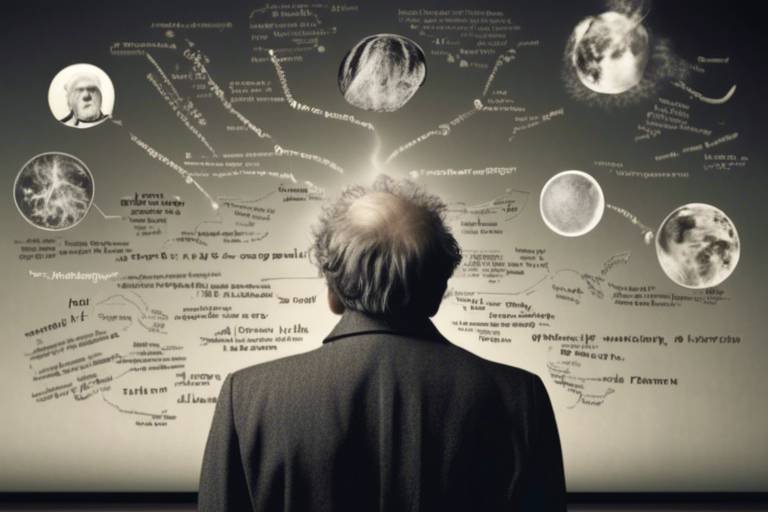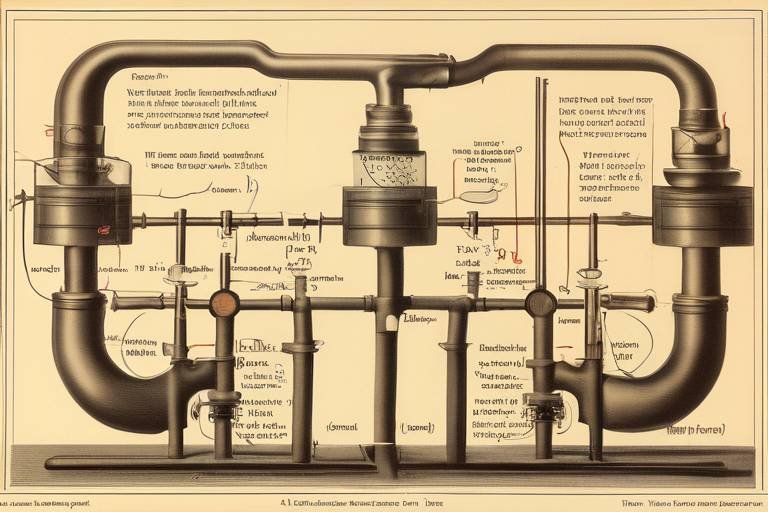Philosophy of Noise - An Exploration into Sound and Acoustics
Welcome to a fascinating journey through the philosophy of noise and sound, where we unravel the intricate threads that weave together our auditory experiences. Sound is everywhere, from the gentle rustle of leaves to the cacophony of city life. But what is it about these vibrations that shapes our perception, culture, and environment? In this article, we will dive deep into the nature of sound, explore the distinctions between noise and sound, and examine the philosophical implications of our auditory experiences. So, grab a cup of coffee, sit back, and let’s make some noise about noise!
To understand the philosophy of noise, we first need to grasp the fundamental characteristics of sound. Sound is a vibrational phenomenon that travels through various mediums such as air, water, and solids. It can be described by its frequency, amplitude, and wavelength, which collectively determine how we perceive it. For instance, a low-frequency sound like a bass drum resonates deeply, while a high-frequency sound, like a whistle, can pierce through the air. This basic understanding sets the stage for exploring deeper philosophical questions surrounding noise and acoustics. How do these vibrations affect our emotions, thoughts, and even our existence?
Ah, the age-old debate: noise versus sound. At first glance, they may seem like interchangeable terms, but they represent distinct concepts shaped by context, intention, and subjective experience. Sound can be melodious and harmonious, while noise often carries a negative connotation, suggesting chaos or disruption. But why is that? The answer lies in our perception. For instance, the sound of waves crashing on the shore might be soothing, while the blaring of a car horn can be jarring. It’s all about the context in which we experience these auditory phenomena.
Context is crucial in defining what we classify as noise or sound. Imagine attending a concert where the music is electrifying, and everyone around you is dancing with joy. In this setting, the loudness is welcomed and celebrated. Conversely, imagine the same volume level on a quiet street at midnight—suddenly, it feels intrusive and unwelcome. Our emotional responses to auditory experiences are heavily influenced by the environment we find ourselves in. This leads us to consider how cultural interpretations also play a significant role in shaping our understanding of soundscapes.
Different societies have unique ways of interpreting and valuing sound. In some cultures, silence is revered, while in others, it’s the vibrant sounds of daily life that are celebrated. For instance, in Japan, the concept of “Ma” emphasizes the importance of silence and pauses in music, suggesting that what is not said can be as powerful as the notes played. In contrast, urban environments often embrace noise as a sign of life and activity. These cultural perspectives not only affect our relationship with noise but also shape our emotional connections to sound.
Our individual experiences further color our understanding of sound and noise. Think about a song that brings back memories of a special moment in your life. The sound becomes intertwined with your emotions, transforming it into something profoundly meaningful. Personal memories and associations can significantly influence how we react to different auditory stimuli. A familiar sound can evoke nostalgia, while an unexpected noise might trigger anxiety. This subjectivity makes the exploration of sound a deeply personal and philosophical endeavor.
As we delve deeper into the philosophical implications of noise and sound, we encounter profound questions about existence, perception, and reality. What does it mean to truly hear? Can sound shape our understanding of the world around us? Philosophers have long pondered the relationship between sound and being. Some argue that sound is an essential part of our reality, while others see it as merely a fleeting experience. This exploration invites us to reflect on our own perceptions and the significance we attribute to the sounds that fill our lives.
In our modern world, the effects of noise pollution cannot be ignored. Excessive noise exposure has significant implications for health, well-being, and the environment. As we navigate through bustling cities, we often forget the toll that constant sound can take on our bodies and minds. It raises ethical considerations about our responsibilities towards sound management and the importance of creating harmonious soundscapes.
Studies have shown that noise pollution poses serious health risks, including increased stress levels, sleep disturbances, and even cardiovascular issues. The relentless roar of traffic or the drone of construction can lead to psychological effects such as anxiety and irritability. It’s essential to acknowledge that our auditory environment plays a critical role in shaping our overall health and quality of life.
The impact of noise extends beyond human health; it profoundly affects wildlife and ecosystems. Animals rely on sound for communication, navigation, and survival. Noise pollution disrupts these natural behaviors, leading to habitat loss and decreased biodiversity. To mitigate these effects, we must consider strategies for creating quieter environments, such as implementing sound barriers and promoting awareness of the importance of acoustic ecology.
Let’s not forget the artistic and aesthetic dimensions of sound. Composers and sound artists have long manipulated noise to create meaning and evoke emotions. From the haunting sounds of a minimalist composition to the chaotic symphony of urban life, sound can be a powerful medium for expression. It challenges our perceptions and invites us to experience the world in new and exciting ways.
- What is the difference between noise and sound? Noise is often considered unwanted or disruptive sound, while sound can be any auditory experience, including music and speech.
- How does noise pollution affect health? Noise pollution can lead to various health issues, including stress, sleep disturbances, and cardiovascular problems.
- Can sound influence our emotions? Absolutely! Sound can evoke powerful emotions and memories, shaping our experiences and perceptions.
- What are some ways to reduce noise pollution? Implementing sound barriers, creating quiet zones, and promoting awareness of noise management are effective strategies.

The Nature of Sound
Understanding the fundamental characteristics of sound is like peeling back the layers of an onion; each layer reveals a deeper truth about our auditory world. Sound, at its core, is a vibration that travels through various mediums—be it air, water, or solid materials. These vibrations create waves that our ears detect, allowing us to experience the rich tapestry of noises that surround us. But what exactly are the physical properties of sound? Well, sound waves are characterized by their frequency, wavelength, and amplitude, each contributing to how we perceive different sounds.
Frequency, measured in hertz (Hz), determines the pitch of the sound. For instance, a high-frequency sound like a whistle can be perceived as shrill and piercing, while a low-frequency sound, like a bass drum, resonates deeply within our bodies. Wavelength, on the other hand, is the distance between successive peaks of the wave, which influences how sound waves interact with each other. Amplitude relates to the loudness of the sound; a greater amplitude means a louder sound, which can evoke strong emotional responses from listeners.
As sound travels, it undergoes various transformations influenced by the environment. For example, sound waves can be reflected, refracted, or absorbed depending on the surfaces they encounter. This is why a sound can echo in a canyon but feel muffled in a thick forest. Each environment presents unique acoustics, shaping the auditory experiences we encounter daily. Understanding these physical properties and behaviors of sound lays the groundwork for diving into the more profound philosophical questions surrounding noise and acoustics.
Moreover, our perception of sound is not merely a physiological process; it is intricately linked to our emotions and memories. Think about it: a song can transport you back in time, evoking nostalgia, or a particular noise can trigger anxiety or discomfort. This emotional connection serves as a reminder that sound is not just a series of vibrations; it is a powerful force that shapes our experiences and influences our understanding of the world. As we explore the philosophy of noise, we must consider these characteristics and their implications on our perception, culture, and environment.
In summary, the nature of sound encompasses an intricate interplay of physical properties and personal experiences. By grasping the fundamentals of sound, we can embark on a journey to explore how these auditory phenomena influence our lives and the world around us. So, the next time you hear a sound, take a moment to reflect on its nature and the myriad ways it impacts your reality.
- What is sound? Sound is a vibration that travels through a medium, creating waves that can be detected by our ears.
- How does sound travel? Sound travels through air, water, or solid materials as waves of varying frequency, wavelength, and amplitude.
- What affects our perception of sound? Factors such as frequency, amplitude, context, and personal experiences significantly influence how we perceive sound.
- Why is understanding sound important? Understanding sound helps us appreciate its impact on our emotions, culture, and the environment, leading to a deeper philosophical exploration of noise.

Noise vs. Sound
When we think about noise and sound, it's easy to assume they're just two sides of the same coin. After all, both terms describe auditory phenomena we encounter daily. However, the distinction between them is far more nuanced than it appears at first glance. Noise is often considered unwanted or disruptive sound, while sound can be any auditory experience, pleasant or unpleasant. But what really defines these two concepts? Is it merely a matter of volume, or is there something deeper at play?
The way we classify noise and sound can be heavily influenced by context, intention, and our personal experiences. For instance, a blaring car horn is likely perceived as noise in a quiet neighborhood, but in the bustling heart of a city, it blends into the symphony of urban life. This leads us to ponder: how much of our auditory experience is shaped by our environment? The answer lies in the intricate relationship between our surroundings and our perception of sound.
Context is a powerful lens through which we interpret sound. Imagine sitting in a serene forest; the rustling leaves and chirping birds create a peaceful soundscape. Now, picture the same sounds in a crowded café. Suddenly, the birdsong feels less like a gentle melody and more like an intrusion. This shift emphasizes how our surroundings can transform sound into noise, or vice versa. Additionally, our emotional state can also influence this interpretation. A song that brings back memories of a loved one can evoke deep emotions, while the same tune might feel like mere background noise to someone else.
Culture plays a crucial role in shaping our understanding of sound and noise. Different societies have unique soundscapes that they cherish or find disruptive. For example, traditional music in one culture may be a source of pride and joy, while in another, it could be perceived as an unwelcome disturbance. This cultural lens not only affects our preferences but also our tolerance levels for various sounds. In some cultures, the sound of a bustling market is a vibrant celebration of life, whereas in others, it might be viewed as chaotic noise.
Our personal histories further color our perceptions of sound and noise. A simple sound, like the ringing of a bell, can evoke different memories for different people. For someone, it might remind them of school days and the end of classes, while for another, it could bring back memories of a loved one’s funeral. These associations can create a profound emotional response, turning what might be considered mere sound into something deeply significant. Our individual experiences shape our auditory landscapes, reminding us that perception is as much about context and culture as it is about personal memory.
In essence, the distinction between noise and sound is not merely a semantic one; it is a reflection of our complex relationship with our auditory environment. As we navigate through life, the sounds we encounter are filtered through our emotions, cultural backgrounds, and personal experiences, ultimately shaping how we perceive and categorize them. The next time you hear a sound, take a moment to consider its context. Is it noise, or is it something more?
- What is the main difference between noise and sound? Noise is typically considered unwanted or disruptive sound, while sound encompasses all auditory experiences, including those that are pleasant.
- How does context affect our perception of sound? The environment in which a sound occurs can greatly influence how we interpret it, turning it into noise or enhancing its significance.
- Can cultural backgrounds change how we perceive noise? Yes, different cultures have unique soundscapes that can affect how individuals interpret and value various sounds.
- How do personal experiences shape our understanding of sound? Personal memories and associations can evoke emotional responses to sounds, making them more significant than mere auditory experiences.

The Role of Context
When we think about sound, it's easy to overlook the profound impact that context has on our auditory experiences. Imagine listening to your favorite song while driving down a scenic highway; the feeling of freedom and joy is amplified by the surroundings. Now, picture the same song playing in a crowded subway station during rush hour. The emotional response shifts dramatically, doesn't it? This illustrates how context shapes our perception of sound and noise, influencing our feelings and reactions.
Context can be defined by various factors, including the physical environment, social settings, and even the emotional state of the listener. For instance, a serene forest filled with the gentle rustle of leaves and birdsong creates a peaceful soundscape that invites contemplation. In contrast, a bustling city street filled with honking cars and construction noise can lead to feelings of stress and anxiety. These environments frame our experiences, turning what might be mere noise into a symphony of sensations or vice versa.
Moreover, the intentionality behind sound also plays a crucial role in how we interpret it. For example, a child's laughter in a park is often perceived as joyful and innocent, while the same sound in a tense family gathering might evoke discomfort. This duality highlights how our understanding of sound is not just about the auditory experience itself but also about the surrounding circumstances that give it meaning. It's like the difference between a well-timed punchline in a comedy club and an awkward silence in a serious meeting; the context dictates our perception.
In addition to physical and social contexts, cultural backgrounds also significantly influence how we perceive sound. Different cultures have varying associations with specific sounds. For example, in some cultures, the sound of bells is seen as a symbol of celebration, while in others, it may signify mourning. This cultural lens adds another layer to our understanding of sound and noise, revealing that what might be harmonious in one culture could be perceived as jarring in another.
Ultimately, the role of context in shaping our auditory experiences cannot be overstated. It acts as a lens through which we interpret sounds, allowing us to derive meaning and emotional responses from our surroundings. Understanding this can lead us to appreciate the richness of our soundscapes and the intricate ways in which they interact with our lives.
- How does context change our perception of sound? Context affects our emotional responses and interpretations of sound, as different environments can evoke various feelings.
- Can cultural differences influence how we perceive noise? Yes, cultural backgrounds shape our associations with sounds, leading to different interpretations of the same auditory experiences.
- Why is it important to consider context when discussing noise pollution? Understanding context helps us recognize that not all noise is perceived negatively; some sounds may be welcomed in specific settings.

Cultural Interpretations
Cultural interpretations of sound and noise are as diverse as the societies that create them. Each culture brings its unique lens through which it perceives and values auditory experiences. For instance, in some cultures, the sound of a bustling market filled with chatter and the clanging of pots is a celebration of life, while in others, it might be perceived as overwhelming noise that disrupts tranquility. This dichotomy highlights how deeply our environmental and social contexts shape our auditory experiences.
Consider the role of traditional music in various cultures. In many Indigenous societies, music is not merely entertainment; it's a spiritual expression and a means of storytelling. The sounds produced during rituals or community gatherings are imbued with meaning, connecting the present with ancestral histories. In contrast, modern urban environments often prioritize noise reduction, viewing silence as a luxury rather than a void. This shift can lead to a disconnection from the rich soundscapes that once defined communal life.
Furthermore, the concept of noise pollution varies across cultures. In densely populated cities, the hum of traffic and construction might be accepted as the soundtrack of progress, while in quieter rural areas, such sounds could be considered intrusive. This cultural relativity extends to how different societies respond to noise complaints; some may advocate for stricter regulations, while others embrace the chaos as part of urban living.
To illustrate this point, let’s take a moment to examine how different cultures interpret specific sounds:
| Cultural Context | Interpretation of Sound |
|---|---|
| Japanese Tea Ceremony | The sound of water boiling is a meditative experience, symbolizing purity and tranquility. |
| Western Classical Music | Complex compositions are valued for their emotional depth and technical mastery. |
| Urban Street Life | The cacophony of city sounds is often seen as a vibrant, dynamic expression of modern life. |
Ultimately, our cultural backgrounds not only shape how we perceive sound but also how we interact with it. This interaction can lead to a deeper appreciation of our auditory environment or a yearning for silence, depending on individual experiences and societal values. As we navigate through different cultures, we begin to understand that sound is not just a physical phenomenon; it is a cultural artifact that reflects our identities, beliefs, and emotional landscapes.

Personal Experience
When we talk about sound and noise, we often overlook the profound impact our personal experiences have on how we perceive them. Think about it: the sound of rain might evoke feelings of calm and serenity for one person, while for another, it could bring back memories of a dreary day spent indoors. This subjective nature of sound is what makes it so fascinating and complex. Our individual histories, emotions, and even our cultural backgrounds shape the way we interpret auditory stimuli.
For instance, a bustling city street might be a source of excitement and energy for some, while others might find it overwhelming and chaotic. This dichotomy can be explained through personal associations. A person who grew up in a vibrant urban environment might find comfort in the sounds of honking cars and distant chatter, while someone from a quiet rural setting might feel stressed or anxious in the same scenario. It's almost like a musical score that plays differently for each listener, influenced by their unique life experiences.
Moreover, our memories can be intricately linked to specific sounds. Consider the smell of freshly baked cookies; it’s often accompanied by the sound of the oven timer beeping. For many, this sound can trigger a flood of childhood memories, evoking warmth and nostalgia. On the other hand, the sound of a siren might bring back distressing memories of an emergency or a traumatic event. This connection between sound and memory highlights the emotional weight that personal experiences carry, shaping not only our perceptions of sound but also our emotional responses to it.
In essence, the way we experience sound is like a tapestry woven from threads of personal history, cultural background, and emotional resonance. It’s essential to recognize that each person's auditory landscape is unique, influenced by the symphony of their life experiences. Understanding this can foster greater empathy and appreciation for the diverse ways people interact with the world of sound.
- What is the difference between sound and noise?
Sound is often perceived as pleasant or meaningful, while noise is typically considered unwanted or disruptive. - How does personal experience influence sound perception?
Personal experiences shape our emotional responses and associations with different sounds, making our perception unique. - Can noise pollution affect mental health?
Yes, excessive noise exposure has been linked to increased stress, anxiety, and other mental health issues. - What are some ways to reduce noise pollution?
Implementing sound barriers, using quieter machinery, and creating green spaces can help mitigate noise pollution.

Philosophical Implications
The exploration of noise and sound opens up a treasure trove of that challenge our understanding of existence and perception. Have you ever paused to consider how the sounds around you shape your reality? Just as light illuminates our surroundings, sound acts as an invisible thread weaving through the fabric of our experiences. It influences our emotions, memories, and even our interactions with the world. This intricate relationship prompts us to ask profound questions: What does it mean to truly hear? How do we distinguish between meaningful sound and chaotic noise?
At its core, the philosophy of sound invites us to ponder the nature of reality itself. Is sound merely a physical phenomenon, or does it carry deeper meanings and connections? For instance, consider the soothing sound of waves crashing against the shore versus the blaring horn of a car in traffic. While both are sounds, they evoke vastly different feelings and thoughts. This disparity leads us to consider the subjectivity of auditory experiences. What resonates with one person may be noise to another, highlighting the role of personal context in shaping our perceptions.
Moreover, the philosophical implications extend beyond individual experiences to touch upon collective consciousness. Soundscapes define our environments and cultures, influencing societal norms and values. For example, in urban settings, the constant hum of activity can be both energizing and overwhelming. In contrast, rural areas might offer a serene soundscape that fosters tranquility. These auditory environments shape our identities and cultural narratives, prompting us to reflect on how sound influences our collective existence.
As we delve deeper, we encounter the idea of sound as a medium of communication. Think about the differences between spoken language and the sounds of nature. Words can convey specific meanings, while natural sounds evoke emotions and memories that words often fail to express. This duality raises questions about the limitations of language and the potential of sound as a more profound means of connection. Can we truly understand each other without considering the sounds that surround us?
In contemplating the implications of sound, we also confront the notion of silence. Often perceived as the absence of sound, silence holds a paradoxical significance. It can be a space for reflection, a canvas for creativity, or even a source of discomfort. How do we navigate the spaces between sound and silence? This relationship offers fertile ground for philosophical inquiry, inviting us to explore the boundaries of our auditory experiences and the meanings we attach to them.
Ultimately, the philosophy of noise and sound challenges us to reconsider our perceptions and the very essence of reality. It compels us to engage with the world in a more profound way, recognizing that every sound we encounter contributes to the rich tapestry of our existence. As we continue to explore these philosophical implications, we are reminded that sound is not just a sensory experience; it is a fundamental aspect of our being, shaping our thoughts, emotions, and connections with others.
- What is the difference between noise and sound? Noise is often considered unwanted or disruptive sound, while sound encompasses all auditory experiences, both pleasant and unpleasant.
- How does sound affect our emotions? Sound can evoke a wide range of emotions, from joy and nostalgia to anxiety and discomfort, depending on the context and individual experiences.
- Why is silence important? Silence allows for reflection, creativity, and mental clarity, serving as a counterbalance to the constant influx of sound in our environments.
- How can we manage noise pollution? Implementing sound management practices, such as sound barriers, urban planning, and community awareness, can help mitigate the effects of noise pollution.

The Impact of Noise Pollution
Noise pollution is often an unseen menace that infiltrates our lives, yet its effects can be profoundly felt. Imagine living in a bustling city where the constant honking of horns, the rumble of trains, and the chatter of crowds create a relentless cacophony. This incessant noise not only disrupts our daily lives but also has serious implications for our health and well-being. The World Health Organization has identified noise pollution as a significant environmental risk, linking it to a range of health issues. But what exactly does this mean for us, and why should we care?
One of the most alarming consequences of noise pollution is its impact on physical health. Studies have shown that prolonged exposure to high noise levels can lead to a variety of health problems, including increased blood pressure, heart disease, and sleep disturbances. The constant barrage of sound can trigger stress responses in our bodies, leading to chronic health issues. For instance, a recent study highlighted that individuals living near airports experienced higher rates of hypertension compared to those in quieter areas.
Moreover, the psychological effects of noise pollution cannot be overlooked. It has been found to contribute to anxiety, depression, and cognitive impairment. Imagine trying to concentrate on a task while loud construction work is happening just outside your window. The inability to focus can lead to decreased productivity and increased frustration, creating a vicious cycle of stress and distraction.
The environmental considerations surrounding noise pollution are equally concerning. Wildlife, for example, is significantly affected by excessive noise. Animals rely on sound for communication, navigation, and hunting. When their habitats are inundated with human-generated noise, it disrupts their natural behaviors and can lead to population declines. Research has shown that species such as birds and marine animals are particularly vulnerable, as they may abandon their nests or fail to communicate effectively with one another.
To illustrate the impact of noise pollution on various aspects of life, consider the following table that summarizes key health effects and their implications:
| Health Effect | Description | Implications |
|---|---|---|
| Increased Blood Pressure | Chronic noise exposure can lead to elevated blood pressure levels. | Higher risk of heart disease and stroke. |
| Sleep Disturbances | Noise can interfere with sleep quality and duration. | Increased fatigue and decreased cognitive function. |
| Psychological Stress | Exposure to noise can trigger anxiety and depression. | Negative impact on mental health and quality of life. |
As we delve deeper into the societal responsibilities surrounding noise management, it becomes clear that we must take action. Communities need to implement stricter regulations on noise levels, especially in residential areas. Public awareness campaigns can educate individuals about the importance of reducing noise pollution, from simple actions like keeping volume levels down to advocating for quieter transportation options.
In conclusion, the impact of noise pollution is a multifaceted issue that affects our health, environment, and overall quality of life. By acknowledging its effects and taking proactive measures, we can create a more harmonious living space for ourselves and future generations. So, the next time you find yourself overwhelmed by noise, remember that it's not just an annoyance—it's a call to action for a quieter, healthier world.
- What is noise pollution? Noise pollution refers to harmful or annoying levels of noise in the environment, often resulting from transportation, industrial activities, and urbanization.
- How does noise pollution affect health? Prolonged exposure to noise pollution can lead to health issues such as hypertension, sleep disturbances, and increased stress levels.
- What can be done to reduce noise pollution? Strategies include implementing stricter regulations, using noise barriers, and promoting quieter technologies in transportation and industry.
- Is noise pollution regulated? Yes, many countries have laws and regulations in place to manage noise levels, particularly in residential areas.

Health Consequences
Noise pollution is not just an annoyance; it can have serious that affect both our physical and mental well-being. Imagine living in a bustling city where the incessant honking of cars, construction sounds, and loud music create a never-ending cacophony. Over time, this exposure to high decibel levels can lead to a range of health issues that many people may not even connect to noise. Studies have shown that prolonged exposure to noise can increase the risk of cardiovascular diseases, disrupt sleep patterns, and even lead to mental health disorders such as anxiety and depression.
To better understand the impact, consider the following health risks associated with noise pollution:
- Cardiovascular Problems: Chronic noise exposure has been linked to hypertension and heart disease. The body's stress response can be triggered by constant noise, leading to elevated blood pressure.
- Sleep Disturbances: Noise can disrupt sleep cycles, causing insomnia and reducing overall sleep quality. This lack of quality rest can lead to fatigue, decreased productivity, and a host of other health issues.
- Mental Health Issues: Continuous exposure to noise can contribute to feelings of stress, anxiety, and even depression. The brain's ability to relax is compromised, making it difficult to unwind.
- Hearing Loss: Prolonged exposure to loud sounds can lead to permanent hearing damage. This is particularly concerning for those who work in noisy environments without proper ear protection.
Furthermore, children and the elderly are particularly vulnerable to the effects of noise pollution. Research indicates that children exposed to high levels of noise may experience delays in cognitive development, while older adults may find their existing health conditions exacerbated. The connection between noise and health is so significant that the World Health Organization has classified noise pollution as a major environmental risk to health.
Addressing the health consequences of noise pollution requires a collective effort. It’s essential for urban planners and policymakers to consider sound management in their designs and regulations. Simple measures, such as creating green spaces, implementing noise barriers, and enforcing stricter noise regulations, can significantly improve the quality of life for residents in noisy areas.
In conclusion, the implications of noise pollution extend far beyond mere discomfort. It infiltrates our lives, affecting our health in profound ways. By understanding these consequences, we can advocate for healthier environments and promote better sound management practices in our communities.
- What is noise pollution? Noise pollution refers to harmful or annoying levels of noise in the environment, often caused by traffic, industry, and urban activities.
- How does noise pollution affect health? It can lead to various health issues, including cardiovascular diseases, sleep disturbances, and mental health problems.
- What can be done to reduce noise pollution? Measures such as implementing noise barriers, creating green spaces, and enforcing noise regulations can help mitigate noise pollution.
- Are certain populations more affected by noise pollution? Yes, children and the elderly are particularly vulnerable to the adverse effects of noise pollution.

Environmental Considerations
The impact of noise pollution on our environment is a pressing issue that often goes unnoticed. Just as a pebble thrown into a pond creates ripples, noise disturbances can have far-reaching effects on wildlife and ecosystems. When we think about pollution, we usually picture smoke-filled skies or plastic-laden oceans, but the unseen waves of sound can be just as damaging. For instance, many animals rely on sound for communication, navigation, and finding food. The incessant hum of urban life can drown out the natural sounds that creatures depend on, leading to disorientation and distress.
Consider the plight of marine life. Underwater noise from ships, construction, and other human activities can interfere with the echolocation of whales and dolphins. These magnificent creatures use sound to navigate vast oceans, and excessive noise can lead to stranding or even death. It's a stark reminder that our actions on land can ripple through the waters, affecting life far beyond our immediate surroundings. In fact, studies have shown that increased noise levels can lead to a decline in fish populations, disrupting entire aquatic ecosystems.
On land, the situation is equally alarming. Birds, for example, often sing to attract mates and establish territory. However, when city sounds rise above their natural calls, it can lead to reduced breeding success and altered behaviors. The chorus of chirps and tweets that once filled our parks and forests is being replaced by a cacophony of horns and machinery. This disruption not only affects individual species but can also lead to a decline in biodiversity, as some species struggle to adapt to these new, noisy environments.
To address these challenges, we need to consider several strategies that can help mitigate noise pollution:
- Urban Planning: Designing cities with noise barriers, green spaces, and sound-absorbing materials can help reduce the impact of noise on both human and wildlife populations.
- Regulations: Implementing strict regulations on noise emissions from industries and transportation can help protect sensitive habitats.
- Public Awareness: Educating communities about the effects of noise pollution and promoting quieter technologies can foster a more harmonious relationship with our environment.
In conclusion, recognizing the profound effects of noise pollution is crucial for preserving our natural world. Just as we strive to protect our air and water, we must also advocate for a quieter planet. By understanding the intricate web of life that sound weaves, we can take meaningful steps towards creating a more sustainable and peaceful coexistence with our environment.
What is noise pollution? Noise pollution refers to excessive or harmful levels of noise in the environment, which can disrupt human activities and harm wildlife.
How does noise pollution affect wildlife? Noise pollution can interfere with communication, navigation, and mating behaviors of animals, leading to stress and population declines.
What are some ways to reduce noise pollution? Strategies include urban planning to create quieter spaces, implementing regulations on noise emissions, and raising public awareness about the impact of noise.
Can noise pollution affect human health? Yes, prolonged exposure to high levels of noise can lead to health issues such as stress, sleep disturbances, and cardiovascular problems.

The Aesthetics of Sound
The aesthetics of sound is a fascinating realm where art, emotion, and auditory experiences converge. When we think of sound, we often consider music, but it encompasses so much more. From the gentle rustle of leaves to the cacophony of a bustling city, sound shapes our perceptions and emotions in profound ways. In this exploration, we will dive into how composers and sound artists harness the power of noise, manipulating it to create deeper meanings and evoke a spectrum of emotions.
Imagine walking through a forest, the sound of birds chirping and leaves crunching underfoot. Each sound contributes to a rich tapestry of auditory experience, one that can evoke feelings of peace and tranquility. This phenomenon is not just random; it’s a deliberate orchestration of sounds that artists and composers strive to replicate and enhance in their works. The way sound interacts with our emotions is akin to how colors interact in a painting—each hue has its own effect, and when combined, they can create something truly magical.
Composers often play with silence and noise, using them as tools to create contrast. For instance, the silence before a powerful crescendo can heighten anticipation, making the eventual explosion of sound all the more impactful. This technique draws listeners in, allowing them to experience a range of emotions, from joy to melancholy. The manipulation of sound and silence can be compared to a chef balancing flavors in a dish; too much of one element can overwhelm the palate, while the right balance can create a symphony of taste.
Moreover, sound artists have taken this exploration further by integrating everyday noises into their works. Consider the use of urban sounds—horns honking, people chatting, and construction noise. These elements, often dismissed as mere background noise, are transformed into art that comments on modern life and our relationship with our environments. This approach challenges traditional notions of music and invites listeners to reconsider what they define as art.
To illustrate the diverse ways in which sound can be aesthetically appreciated, we can categorize sound experiences into several types:
- Natural Sounds: The soothing sounds of nature, such as rain, waves, or wind, often evoke feelings of calmness and connection to the earth.
- Musical Compositions: Structured pieces of music that utilize melody, harmony, and rhythm to convey emotions and narratives.
- Soundscapes: These are immersive auditory environments that can range from urban soundscapes to abstract compositions, designed to evoke specific feelings or thoughts.
- Noise Art: This genre challenges the boundaries of sound, using dissonance and unconventional noise to provoke thought and elicit emotional responses.
As we navigate through this auditory landscape, it’s essential to recognize the role of the listener. Each person's background, experiences, and even mood can drastically alter how they perceive sound. What one person finds beautiful, another might consider noise. This subjective experience is what makes the aesthetics of sound so rich and varied. It’s a reminder that sound, much like art, is open to interpretation, and our personal connections to it can be deeply revealing.
In conclusion, the aesthetics of sound is not just about the notes we hear or the noise we encounter; it's about the emotional journeys they take us on. As we continue to explore and appreciate the sounds around us, we uncover layers of meaning that enrich our lives and deepen our understanding of the world. The next time you listen to a piece of music or find yourself in a bustling environment, take a moment to consider the artistry behind the sounds. You may discover a new appreciation for the auditory tapestry that surrounds you.
- What is the difference between sound and noise? Sound is typically organized and pleasant to the ear, while noise is often considered disorganized and unpleasant. However, this distinction can be subjective.
- How do composers use silence in their works? Silence can create tension and anticipation, making the sounds that follow more impactful. It's a powerful tool in music composition.
- Can everyday sounds be considered art? Yes! Many sound artists incorporate everyday noises into their works, challenging traditional definitions of music and art.
- How does culture influence our perception of sound? Cultural backgrounds shape how we interpret sounds, leading to different emotional responses and aesthetic values across societies.
Frequently Asked Questions
- What is the difference between noise and sound?
Noise and sound are often confused, but they have distinct meanings. Sound is a general term that refers to any auditory phenomenon, while noise typically refers to sounds that are disruptive or unwanted. Context plays a significant role in this distinction; what may be noise in one setting could be perceived as sound in another.
- How does culture influence our perception of sound?
Cultural background shapes how we interpret and value different soundscapes. For instance, in some cultures, the sound of bustling city life is energizing, while in others, it might be overwhelming. These differing perspectives affect how we react to noise and sound, highlighting the subjective nature of auditory experiences.
- What are the health effects of noise pollution?
Noise pollution can lead to a myriad of health issues, including stress, sleep disturbances, and even cardiovascular problems. Prolonged exposure to excessive noise can negatively impact both physical and mental well-being, making it crucial to address and manage noise levels in our environments.
- How does noise pollution affect wildlife?
Noise pollution can disrupt natural habitats, affecting wildlife behavior and communication. Animals rely on sound for mating, navigation, and warning signals. Increased noise levels can lead to stress and disorientation, ultimately threatening their survival and the balance of ecosystems.
- What philosophical questions arise from our experiences with sound?
Sound and noise prompt profound philosophical inquiries about existence and perception. Questions like "What is reality?" and "How do our senses shape our understanding of the world?" emerge from our interactions with auditory phenomena, inviting deeper exploration into the nature of consciousness and experience.
- Can noise be considered art?
Absolutely! Many composers and sound artists use noise intentionally to evoke emotions and convey meaning in their work. The manipulation of sound, including noise, allows for creative expression and can challenge traditional notions of beauty and aesthetics in music and art.



















